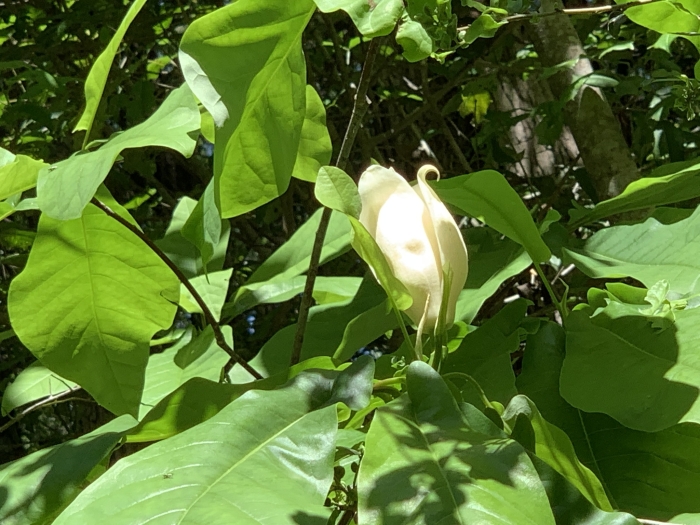Pyramid Magnolia
(Magnolia pyramidata)
Pyramid Magnolia (Magnolia pyramidata)
/
/

Laura Clark
CC BY 4.0
Image By:
Laura Clark
Recorded By:
Copyright:
CC BY 4.0
Copyright Notice:
Photo by: Laura Clark | License Type: CC BY 4.0 | License URL: http://creativecommons.org/licenses/by/4.0/ | Rights Holder: Laura Clark | Publisher: iNaturalist | Date Created: 2020-04-14T17:32:55Z |










































Estimated Native Range
Summary
Magnolia pyramidata, commonly known as Pyramid Magnolia, is a deciduous tree native to the moist, acidic soils of forested floodplains, riverbanks, and wet woodlands in the southern United States. It typically grows to a height of 40 feet (14 meters) with a pyramidal to rounded form. The leaves are large, up to 10 inches long, and contribute to the coarse-textured appearance of the tree. The Pyramid Magnolia is particularly noted for its large, fragrant, showy white flowers, which can be 6–10 inches in diameter, with nine tepals that bloom in late spring or early summer, after the leaves have fully emerged. The fruit is an aggregate of follicles that mature in late summer to early fall, providing food for wildlife and aiding in seed dispersal.
The Pyramid Magnolia is valued for its ornamental qualities, including its striking flowers and large leaves. It is often used in native plant gardens, as a specimen tree, and for naturalistic landscaping. It is also planted for its adaptability to wet soils, making it suitable for riparian plantings. While it prefers part shade, it can tolerate full sun if kept adequately moist. It requires acidic, rich, moist, well-drained soil for optimal growth. This species is relatively low-maintenance but can be susceptible to leaf spot diseases and damage from late frosts due to its early leafing. It is not known to have aggressive roots or to be invasive when grown outside its native range. Gardeners should be aware that it may require protection from frost in northern parts of its cultivation range.CC BY-SA 4.0
The Pyramid Magnolia is valued for its ornamental qualities, including its striking flowers and large leaves. It is often used in native plant gardens, as a specimen tree, and for naturalistic landscaping. It is also planted for its adaptability to wet soils, making it suitable for riparian plantings. While it prefers part shade, it can tolerate full sun if kept adequately moist. It requires acidic, rich, moist, well-drained soil for optimal growth. This species is relatively low-maintenance but can be susceptible to leaf spot diseases and damage from late frosts due to its early leafing. It is not known to have aggressive roots or to be invasive when grown outside its native range. Gardeners should be aware that it may require protection from frost in northern parts of its cultivation range.CC BY-SA 4.0
Plant Description
- Plant Type: Tree
- Height: 10-18 feet
- Width: 10-16 feet
- Growth Rate: Moderate
- Flower Color: Cream, White
- Flowering Season: Spring
- Leaf Retention: Deciduous
Growth Requirements
- Sun: Full Sun, Part Shade
- Water: Medium
- Drainage: Medium, Fast
Common Uses
Bee Garden, Bird Garden, Butterfly Garden, Deer Resistant, Fragrant, Showy Flowers
Natural Habitat
native to the moist, acidic soils of forested floodplains, riverbanks, and wet woodlands in the southern United States
Other Names
Common Names:
Scientific Names: , Magnolia pyramidata, Magnolia fraseri var. pyramidata, Magnolia auriculata var. pyramidata, Magnolia fraseri subsp. pyramidata, Magnolia umbrella var. pyramidata, Paramagnolia fraseri var. pyramidata,
GBIF Accepted Name: Magnolia fraseri var. pyramidata (W.Bartram) Pamp.